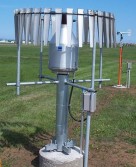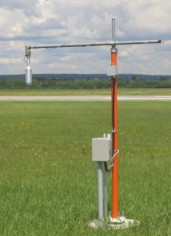|
|
 |
|
All-Weather Precipitation Gauge
|
|
| At automatic weather stations, a single
gauge is used to measure the amount of both rainfall and snowfall.
The 2 main types of all-weather
precipitation gauges used by Environment Canada are the Fischer
and Porter weighing gauge and the Geonor. Both operate
basically the same way and will tell us the amount of
precipitation in millimetres. The metal pickets surrounding
the gauge are designed to disrupt the wind flow, slowing it down
so that precipitation can be captured rather than carried across
the top of it. |
|

|
An opening on the top of the cover
directs precipitation into a bucket inside--in the picture at
right, the cover is removed to show the blue bucket. This bucket sits on a
weighing mechanism and as more precipitation flows into the
bucket, the bucket gets heavier. The weight gain tells us
how much precipitation has fallen. To keep the water from
evaporating out of the bucket and confusing our readings, a small
amount of oil floats on top of the water. |
 |
| Snow is trickier to capture than
rain. If you look closely at the picture above on the left,
you'll see an anemometer mounted on a red post at the same height as the
precipitation gauge. It's important to compensate for wind
strength at that level, as strong winds will carry the snow flakes
across the top of the gauge, allowing less than half the snow
that's falling to actually be captured. Because of the
colder winter temperatures, anti-freeze is added to the bucket to melt
the snow so that its water content can be measured accurately.
At automatic stations, there's no human observer to decide
whether the rain is freezing on impact or to measure the snow on
the ground. That's why we sometimes supplement the Geonor
with additional equipment like a snow depth sensor. |
 |
The silver capsule dangling from the
left end of the crossbar in this picture is an ultrasonic snow depth sensor. It sends a high-frequency pulse of sound
toward the ground. Because we know the speed of sound, the
length of time required for the pulse to travel to the ground and
back up to the sensor tells us how far it is to the snow surface,
and by extension, how much snow is on the ground. The change
in readings from one day to the next also indicates how much new
snow has accumulated. |
|
|
|
|
|
|
|
|
|
|
|